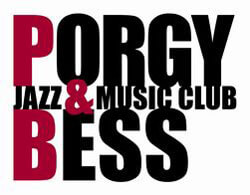
Michael Wertmüller (photo credit: Leonhard Mülheim)
The third night of this series on November 23 was a very intense show featuring Wertmüller’s work written for the “Hammond Avantcore Trio” Steamboat Switzerland. Dominik Blum on Hammond organ (with a gorgeous Leslie speaker cabinet!) and synths, Marino Pliakas on electric bass and Lucas Niggli on drums made full use of their leather pants, two, 8-foot-high amplifier stacks, fully-miked drum kit and the giant in-house PA. The tsunami of sound they produced was not very well managed at the sound board, resulting in periods of unintentional muddiness, but the gig was fascinating in spite of this.
Wertmüller’s pieces for this trio combined complexly-constructed written sections with free improvisation. His vocabulary is pulled from 1970s rock and 1980s punk and metal. In pieces like Zeitschrei parts I-III, z.rat parts I-IV, and Häuser X, he reinterprets elements from these decades, not looking down on them as an elevated classical composer, but using them as genuine building blocks for composition. His adoration for this era of rock music is evident; these works sounded at times like musical fan fiction, though without the amateurism implied by that term.
Steamboat Switzerland (photo credit: Mark Kilchemann)
The two sets, in which one composition bled into the next, started with an aggressive hard rock sound with driving drums, which shifted constantly in metre, tempo and timbre. Imagine a Janacek string quartet, built by splicing different themes into one another, but using heavy metal, psychedelic ambient, punk and noise music instead of eastern-European folk tunes as material. This structural device was incredibly successful. Though the music was a sonic onslaught, it was not constant or unbearable. The harmonic material oscillated between consonance and dissonance, the rhythmic material between recognizable grooves and unintelligibly complex poly-rhythms. The intelligence in design was evident throughout, with breathing room (silence; or long, held, consonant chords in the organ; or a patter of tiny scratching sounds in the drums) provided just at the moment when one texture was about to become overwhelmingly, monotonously loud.
These compositions derived their main material from the drums, setting up elaborate poly-rhythms and long, clever rhythmic tricks by layering organ over bass over drum lines. At times, the band sounded like Queen without Freddie Mercury: complex harmonic and rhythmic ideas with no melodic focal point, a compositional decision that did not sound accidental. After the set break, in ROGLU for electric bass and drums (2004) and Sektio for Hammond organ, electric bass and drums (2013), Wermüller brought his laptop onstage, which changed the array of available textures somewhat. In this set, we heard electronic white noise, beats, rising and falling pitches, and a quote from the Mozart Requiem in the bass added to the previous mix of sounds.
Steamboat Switzerland performed these two sets with the kind of intensity that a composer usually only dreams of. Their focus in the gruelingly-difficult written portions was absolute. Their improvisations were varied and interesting, creating shapes that flowed well from one written section to another. Their interactions on stage were fun to watch, as they cued each other into different sections with elaborate arm waves, or the throwing of drum sticks, or intense death-stares. Dominik Blum added to the intensity in the middle of the first set, scaring away the faint-of-heart with his heavy-metal vocal growling. Because of their fantastic musicianship, and Wertmüller’s steely control of form and mood, this experiment in chamber music for the math-rock set made for very fun listening.
